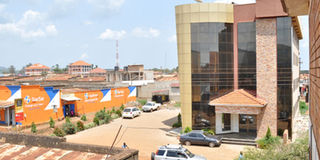Why municipalities want elevation to cities

A view of Hoima town. Infrastructure in the town is fast developing since the discovery of oil in the area. PHOTO BY Rachel Mabala
President Museveni’s pledge to upgrade Arua Municipality to a city has most probably roused the residents of Mbale, Jinja and Mbarara municipalities.
Jinja Municipality has since 2006 been asking to be upgraded to a city whereas Mbarara began demanding for the same in 2008.Though the Cabinet has since endorsed the creating of the cities, Parliament has not yet ratified them.
Why the clamour for cities?
First, the National Development Plan II, the second of six five–year plans aimed at achieving Vision 2040, provides for the creation of four cities.
It proposes the establishment of cities in Gulu, Mbale, Mbarara and Arua and five strategic cities.
The strategic cities would be established in Hoima (oil), Nakasongola (industrial), Fort Portal (tourism), Moroto (mining) and Jinja (as an industrial city).
Second, the reasons for wanting an upgrade from municipal to city status range from creating job opportunities to getting more funds from the central government.
“It is more about employment,” says Dr Gabriel Ajedra Aridru. “Investors would want to know why a place has been granted city status. They would want to establish businesses there.”
Many will set up shop in the new cities as industrialists, on the assumption that people in cities have purchasing power.
Once investors establish factories, job opportunities would be created, which would help address unemployment.
The Mayor of Jinja Municipality, Ah Hajj Muhammad Baswale Kezaala, adds that it is about more resources from the central government to the newly created cities.
“It means we would get additional funding, which money would help us in service delivery,” Baswaale says.
The services include the construction of city roads, garbage collection, building primary schools and health centres.
The Local Government Act 1997 considers a city to be equivalent to a district, which is bigger than a municipality.
Dr Ajedra Aridru adds that it is also about a legacy, the mention that would be made of the people who pushed for the creation of the city.
How municipality qualifies to be city?
For an area to qualify, it should have a population of 350,000 people. It used to be 500, 000.
However, because there are few municipalities with 500, 000 the government reduced it to 350, 000.It should have a master plan for land use. Such a plan could from time to time be reviewed to address emerging issues.
The municipality to be granted city status must have office space.
It should also have water sources and be able to meet the cost of providing social services. According to Uganda’s National Population and Housing Census 2014 Provisional Results, the population of Arua Municipality is 62, 657.
The same results indicate Mbarara’s is 195, 013, Gulu’s 152, 276 whereas Mbale’s is 96, 189. On the population criterion, all the four proposed cities are short of the numbers.
What they are doing to address this is to have their councils vote in support of merging with some nearby town councils.
The case of Arua, for instance, Arua Municipality whose population is 62, 657 would merge with Pajulu (60, 210), Oluko (38, 491), Ayivuni (22, 528), Aroi (24, 241), Manibe (28, 938) and Vurra (133, 640).
Jinja Municipality (whose human population is 72, 931) will take up Budondo (51, 560), Mafubira (78, 895), Kakira, Busedde (36, 152) and Bugembe Town Council (41, 323).
It is not clear which areas Mbarara and Gulu municipalities would merge with to meet the population criterion.
Some of the outlying areas they want to merge with have do not have master plans or have insufficient revenue streams.
A city should be able to rise upwards of 50 per cent of the revenue it needs for its projects.
With the scrapping of poll tax ahead of the 2006 general election, many local government – and the municipalities earmarked for cities – rely heavily on central government transfers.
Like Arua and Jinja, they have master plans for the development of their areas.Jinja though has a water source, being close to Lake Victoria, and a master plan.
Implication of creating a city?
According to the ministry of Finance, the cost of creating a new district is Shs16.63 billion.
The new administrative unit would also require Shs59.25 billion in its first year of existence.
The money goes to paying for building and operating a new administrative unit’s offices, a public service commission, the political leaders salaries and gratuity as well as the statutory bodies officials salaries, allowances and gratuity.
According to the Local Government Sector Strategic Plan 2013–2023, wage transfers from the central government to the local governments have since the 2006/07 Fiscal Year increased from Shs541 billion to Shs1.07 trillion (2013/14) – 4 per cent of Uganda’s current budget.
To that end, the Secretary to the Treasury, Mr Keith Muhakanizi, has repeatedly said it is unaffordable, unsustainable to create more administrative units.
In the lead up to elections, some politicians and legislators increasingly demand for the creation of additional administrative units. Often times, the government grants them. For instance, starting next financial year, the government will create additional 25 districts.
slum scare
According to respondents interviewed by Daily Monitor, Some areas want to become cities because they have run out of land for expansion. By merging with the outlying, land–rich areas, they would be able to get land.
Reports indicate that cities have challenges, because they attract many people from the rural areas, those that fail to get jobs and do not have money to sustain themselves in town contribute to the creation of slums. If not planned well, they face motorized traffic problems, air pollution, and shortage of decent housing. Cities that have slums nearby have to contend with crime




